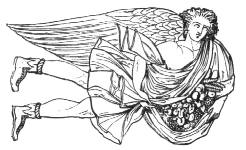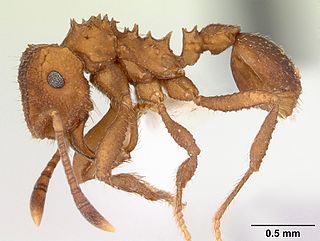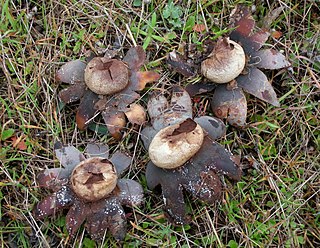
In Greek mythology, Astraeus or Astraios was an astrological deity. Some also associate him with the winds, as he is the father of the four Anemoi, by his wife, Eos.
Iceland Express was a low-fare airline headquartered in Reykjavík, Iceland that was acquired by WOW air. It operated services to several destinations in Europe using wet-leased aircraft. Its main base was Keflavík International Airport.

Astraeus Limited, trading as Astraeus Airlines, was a British airline based at Astraeus House in Crawley, West Sussex, England. Founded in 2002, and named after the Greek God of the dusk, it entered administration on 21 November 2011, ceasing operations the same day.

Pholiotina cyanopus is a species of fungus that contains psychoactive compounds including psilocybin and the uncommon aeruginascin. Originally described as Galerula cyanopus by American mycologist George Francis Atkinson in 1918. It was transferred to Conocybe by Robert Kühner in 1935 before being transferred to Pholiotina by Rolf Singer in 1950. A 2013 molecular phylogenetics study found it to belong to a group of species currently assigned to Pholiotina that are more closely related to Galerella nigeriensis than to Pholiotina or Conocybe. It is likely that it will be moved to a different genus in the future, but this has not happened yet.

Alexander Hanchett Smith was an American mycologist known for his extensive contributions to the taxonomy and phylogeny of the higher fungi, especially the agarics.

Mycocepurus smithii is a species of fungus-growing ant from Latin America. This species is widely distributed geographically and can be found from Mexico in the north to Argentina in the south, as well as on some Caribbean Islands. It lives in a variety of forested habitats and associated open areas. Two studies published in 2009 demonstrated that some populations of the species consist exclusively of females which reproduce via thelytokous parthenogenesis. A detailed study found evidence of sexual reproduction in some populations in the Brazilian Amazon. Accordingly, M. smithii consists of a mosaic of sexually and asexually reproducing populations. In asexual populations all ants in a single colony are female clones of the queen. Inside the colony, the ants cultivate a garden of fungus grown with pieces of dead vegetable matter, dead insects, and insect droppings.

Mycocepurus is a Neotropical genus of fungus-growing ants in the subfamily Myrmicinae. The genus is known from Mexico, south to Brazil and Argentina. Like other attines, they primarily grow fungi of the tribe Leucocoprini. They use many different substrates for growing their fungi, from dry leaves and caterpillar dung to fruit matter. One of its species, Mycocepurus smithii, which lives in South America, reproduces by cloning – all ants in a colony are clones of the queen. M. castrator is a parasite of M. goeldii.

Astraeus hygrometricus, commonly known as the hygroscopic earthstar, the barometer earthstar, or the false earthstar, is a species of fungus in the family Diplocystaceae. Young specimens resemble a puffball when unopened. In maturity, the mushroom displays the characteristic earthstar shape that is a result of the outer layer of fruit body tissue splitting open in a star-like manner. The false earthstar is an ectomycorrhizal species that grows in association with various trees, especially in sandy soils. A. hygrometricus was previously thought to have a cosmopolitan distribution, though it is now thought to be restricted to Southern Europe, and Astraeus are common in temperate and tropical regions. Its common names refer to the fact that it is hygroscopic (water-absorbing) and can open up its rays to expose the spore sac in response to increased humidity, then close them up again in drier conditions. The rays have an irregularly cracked surface, while the spore case is pale brown and smooth with an irregular slit or tear at the top. The gleba is white initially, but turns brown and powdery when the spores mature. The spores are reddish-brown and roughly spherical with minute warts, measuring 7.5–11 micrometers in diameter.

Astraeus is a genus of fungi in the family Diplocystaceae. The genus, which has a cosmopolitan distribution, contains nine species of earthstar mushroom. They are distinguished by the outer layer of flesh (exoperidium) that at maturity splits open in a star-shape manner to reveal a round spore sac. Additionally, they have a strongly hygroscopic character—the rays will open when moist, but when hot and dry will close to protect the spore sac. Species of Astraeus grow on the ground in ectomycorrhizal associations with trees and shrubs. Despite their similar appearance to the Geastrum earthstars Astraeus is not closely related.
Astraeus is a genus of "jewel beetles" in the subfamily Polycestinae, containing the following species:
Astraeus odoratus is a species of false earthstar in the family Diplocystaceae. Described as a new species in 2004, it was originally found in the Thai highlands growing in sandy or laterite-rich soil in dry lowland dipterocarp forests. The species is found in Southeast Asia.

Astraeus pteridis is a species of false earthstar in the family Diplocystaceae. It was described by American mycologist Cornelius Lott Shear in 1902 under the name Scleroderma pteridis. Sanford Myron Zeller transferred it to Astraeus in a 1948 publication. It is found in North America. A. pteridis was previously frequently confused with the supposedly cosmopolitan A. hygrometricus, now shown to be found only in Europe.

Cortinarius smithii is an agaric fungus of the genus Cortinarius. Originally named Cortinarius phoeniceus var. occidentalis by American mycologist Alexander H. Smith in 1939, it was renamed to honor Smith in 2012, after molecular analysis revealed that it was genetically different from Cortinarius phoeniceus. It is found in North America.

Astraeus morganii is a species of false earthstar in the family Diplocystaceae. The fungus is found in the central to southern United States, extending southwards to Mexico. It is closely related to Astraeus pteridis, but has smaller fruit bodies and larger spores. The specific epithet honors American botanist Andrew Price Morgan.

Astraeus telleriae is a species of false earthstar in the family Diplocystaceae. Described as new to science in 2013, it is found in the Mediterranean region, from southern Spain to Greece. The specific epithet honours Spanish mycologist Maria Teresa Telleria.

Astraeus sirindhorniae is a species of false earthstar in the family Diplocystaceae. A. sirindhorniae can be distinguished from close relatives A. odoratus, A. asiaticus and A. hygrometricus by differences in fruit body size, spore size, spore ornamentation, and peridium structure. The fungus was discovered in Phu Khieo Wildlife Sanctuary in northeastern Thailand, as part of a project to document the biodiversity of mycorrhizal fungi. The specific epithet sirindhorniae honors Princess Maha Chakri Sirindhorn on the occasion the 84th birthday of her father, King Bhumibol Adulyadej. Known only from north and northeastern Thailand, A. sirindhorniae is suspected to be ectomycorrhizal with members of the Dipterocarpaceae, although this has not yet been proven.
Penicillium smithii is a species of fungus in the genus Penicillium which produces citreoviridin and canescin Penicillium smithii occurs in soil in Canada and Europe
Boletopsis smithii is a species of hydnoid fungus in the family Bankeraceae. It was described as new to science in 1975 by mycologist Keith A. Harrison, from collections made in Washington.
Astraeus is a titan in Greek mythology.













